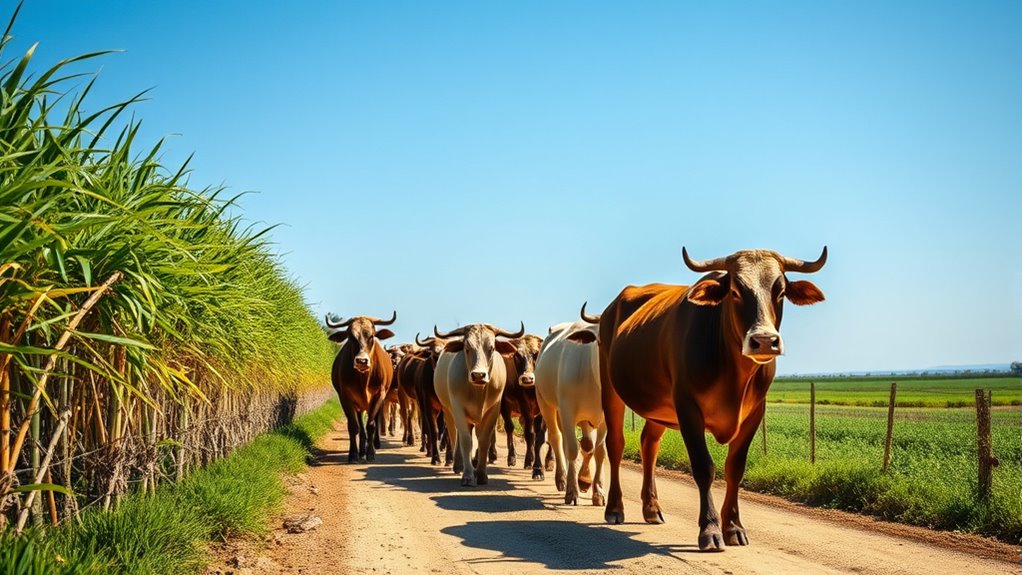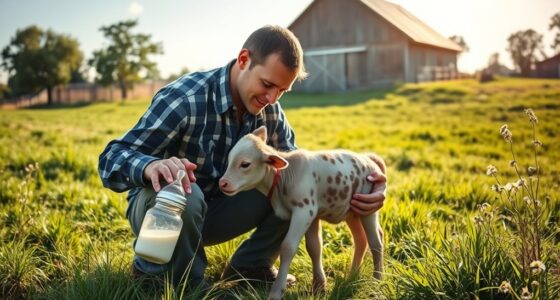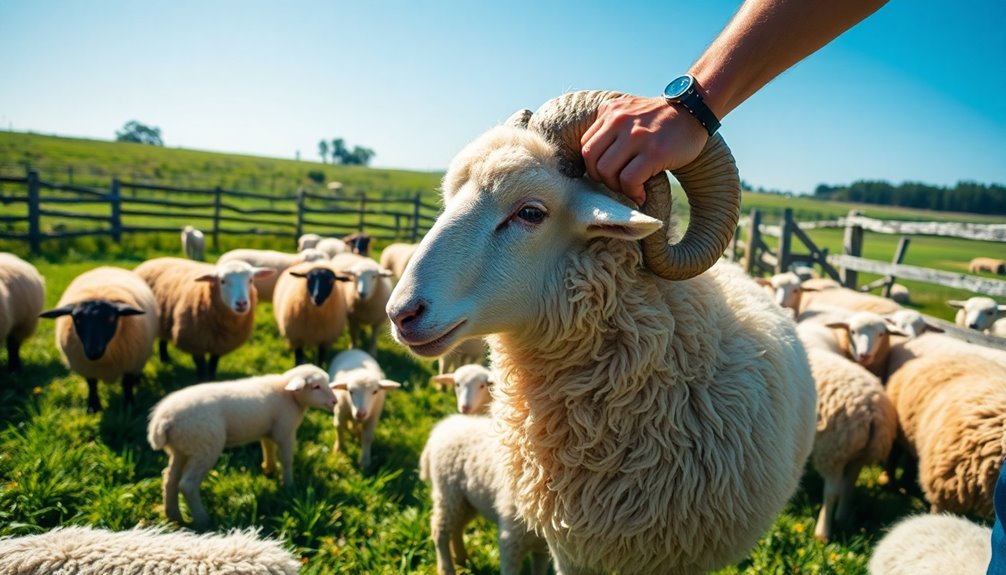When handling and transporting livestock humanely, you should focus on minimizing stress by using proper restraint systems and calm, gentle techniques. Keep your environment quiet, well-lit, and free of sudden noises or movements to help animals stay relaxed. Make sure equipment fits correctly to prevent injuries and handle animals quickly and efficiently. If you continue exploring, you’ll discover more ways to guarantee safe, ethical treatment throughout the entire process.
Key Takeaways
- Use well-designed restraint systems and ensure proper fitting to minimize discomfort and injuries during handling.
- Handle livestock calmly with slow movements, quiet voices, and familiar routines to reduce stress.
- Keep transportation environments quiet, well-lit, and free of sudden noises or objects to promote animal comfort.
- Limit handling and transportation duration to decrease stress and prevent health issues.
- Train handlers in humane techniques to ensure safe, ethical, and effective livestock management.

Have you ever wondered how livestock should be managed to guarantee their well-being? Managing animals humanely starts with understanding their behavior and minimizing stress during handling. Cattle stress is a common concern, especially during routine procedures like vaccinations, weighing, or moving animals from one location to another. When cattle feel threatened or uncomfortable, their stress levels spike, which can lead to increased heart rates, hormonal imbalances, and even long-term health issues. To prevent this, proper livestock restraint is essential. Instead of using rough or overly restrictive methods, you should opt for gentle, well-designed restraint systems that allow animals to feel secure without causing pain or fear. Proper restraint techniques reduce both stress and the risk of injury to animals and handlers alike.
When managing livestock, it’s *essential* to recognize that cattle are sensitive creatures that respond poorly to sudden movements or loud noises. Using calm voices and slow movements helps keep animals relaxed. Livestock restraint devices, like chutes or headlocks, should be used carefully and correctly to avoid unnecessary distress. The goal is to restrain animals just enough for safe handling, not to cause them discomfort. Good restraint practices involve understanding each animal’s behavior, avoiding force, and ensuring that the restraint equipment fits properly. Overly tight or poorly fitted restraints can lead to injuries and increase stress, making future handling more difficult. Training handlers to use restraint equipment properly is *crucial*; they should always prioritize the animals’ comfort and safety. Incorporating humane handling techniques can significantly improve the overall well-being of livestock during management procedures.
Handling procedures should be quick and efficient to minimize the time animals spend in restraint. The longer livestock are restrained, the higher their stress levels become, which can negatively impact their immune system and overall health. Using familiar routines and calm handling techniques creates a more comfortable environment for the animals. It’s also helpful to keep the environment quiet, well-lit, and free of sudden movements or unfamiliar objects. When livestock are handled gently and with patience, their stress levels decrease, making future handling easier and less traumatic for everyone involved.
Frequently Asked Questions
How Can I Identify Signs of Stress in Transported Livestock?
You can identify signs of stress in transported livestock by observing behavioral cues like restlessness, vocalization, and excessive movement. Physical indicators include labored breathing, pale or swollen mucous membranes, and sweating or trembling. Keep a close eye on their posture and eye clarity, as these also signal discomfort. Recognizing these signs early permits you to take quick action to reduce stress and ensure their well-being during transport.
What Are the Legal Penalties for Non-Compliance With Humane Handling Laws?
Like a ripple spreading across water, non-compliance with humane handling laws triggers serious legal consequences. You could face hefty fines, license suspension, or even criminal charges. Penalty enforcement is strict to guarantee animal welfare. Ignoring these laws puts your operation at risk and can lead to costly legal battles. Staying compliant not only protects animals but also keeps your business running smoothly and avoids severe penalties.
How Does Transportation Impact the Long-Term Health of Livestock?
Transportation considerably impacts the long-term health of livestock through transport stress, which can cause injuries, weight loss, and weakened immune systems. If you don’t minimize stress during transit, animals may develop chronic issues like joint problems or respiratory conditions. Proper handling, adequate ventilation, and reducing transit time help protect their long-term health. Ensuring humane practices during transport ultimately benefits both animal welfare and your farm’s productivity.
Are There Specific Breeds More Sensitive to Handling and Transport?
You might think all livestock handle transport equally, but breed sensitivity varies due to genetic predispositions. Some breeds, ironically, are more fragile and struggle with handling and transport, despite their tough reputation. These breeds often have specific vulnerabilities, making them more prone to stress and injury. As a handler, understanding these breed differences helps you tailor your approach, ensuring better welfare and healthier long-term outcomes for the more sensitive livestock.
What Training Is Recommended for Handlers to Improve Animal Welfare?
You should undergo thorough training in handling techniques to guarantee animal welfare. Focus on gentle, low-stress methods that reduce fear and injury. Additionally, learn emergency response procedures to handle unexpected situations calmly and effectively. Proper training helps you recognize signs of distress, handle animals safely, and improve their overall well-being during transport and handling. This proactive approach fosters humane treatment and minimizes stress for livestock.
Conclusion
By handling and transporting livestock humanely, you ensure their wellbeing and reduce stress. Remember, over 80% of cattle experience less stress when treated kindly, leading to healthier animals and better product quality. Every gentle touch and careful movement you make can greatly impact their lives. Your actions not only promote ethical practices but also foster trust and respect in the industry. So, keep compassion at the forefront—your care makes all the difference.










